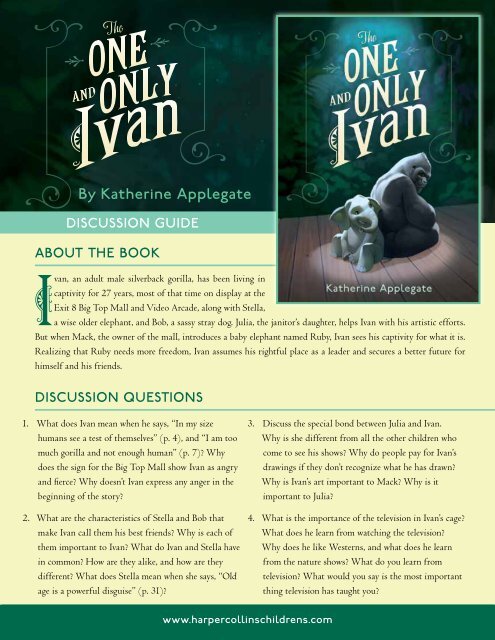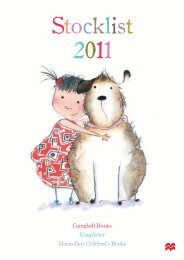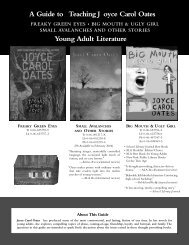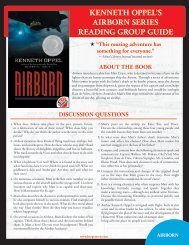By Katherine Applegate
By Katherine Applegate
By Katherine Applegate
Create successful ePaper yourself
Turn your PDF publications into a flip-book with our unique Google optimized e-Paper software.
<strong>By</strong> <strong>Katherine</strong> <strong>Applegate</strong><br />
Discussion GuiDE<br />
ABout thE BooK<br />
Ivan, an adult male silverback gorilla, has been living in<br />
captivity for 27 years, most of that time on display at the<br />
Exit 8 Big Top Mall and Video Arcade, along with Stella,<br />
a wise older elephant, and Bob, a sassy stray dog. Julia, the janitor’s daughter, helps Ivan with his artistic efforts.<br />
But when Mack, the owner of the mall, introduces a baby elephant named Ruby, Ivan sees his captivity for what it is.<br />
Realizing that Ruby needs more freedom, Ivan assumes his rightful place as a leader and secures a better future for<br />
himself and his friends.<br />
Discussion QuEstions<br />
1. What does Ivan mean when he says, “In my size<br />
humans see a test of themselves” (p. 4), and “I am too<br />
much gorilla and not enough human” (p. 7)? Why<br />
does the sign for the Big Top Mall show Ivan as angry<br />
and fierce? Why doesn’t Ivan express any anger in the<br />
beginning of the story?<br />
2. What are the characteristics of Stella and Bob that<br />
make Ivan call them his best friends? Why is each of<br />
them important to Ivan? What do Ivan and Stella have<br />
in common? How are they alike, and how are they<br />
different? What does Stella mean when she says, “Old<br />
age is a powerful disguise” (p. 31)?<br />
www.harpercollinschildrens.com<br />
3. Discuss the special bond between Julia and Ivan.<br />
Why is she different from all the other children who<br />
come to see his shows? Why do people pay for Ivan’s<br />
drawings if they don’t recognize what he has drawn?<br />
Why is Ivan’s art important to Mack? Why is it<br />
important to Julia?<br />
4. What is the importance of the television in Ivan’s cage?<br />
What does he learn from watching the television?<br />
Why does he like Westerns, and what does he learn<br />
from the nature shows? What do you learn from<br />
television? What would you say is the most important<br />
thing television has taught you?
The One and Only Ivan<br />
5. Why is Bob so independent? What makes him trust<br />
Ivan enough to sleep on Ivan’s stomach? What events<br />
in Bob’s life have shaped his personality? How does<br />
Bob’s experience with humans compare to Ivan’s?<br />
6. Compare the personalities of Mack and George. How<br />
are they alike, and how are they different? What is the<br />
meaning of “family” to each of them? What are the<br />
contradictions in Mack’s character?<br />
7. What does Stella mean when she says, “A good zoo<br />
is how humans make amends” (p. 64)? What is the<br />
importance of the story that Stella tells about Jambo<br />
(pp. 63-66)? What does it tell us about gorillas?<br />
Compare that story to Ruby’s story about the humans<br />
who rescued her in the jungle (pp. 101-104). What<br />
does this story tell us about some humans?<br />
8. What is Ivan’s initial reaction to the arrival of Ruby?<br />
Compare Ruby’s arrival with that of a new baby in a<br />
human household. How does her arrival affect all the<br />
other animals at the mall? When and why do Ivan’s<br />
feelings about Ruby change?<br />
9. Why does Ivan promise Stella that he will take care<br />
of Ruby when he knows how hard it will be to keep<br />
that promise? How does Ivan know that Stella is gone<br />
before anyone else does?<br />
Discussion GuiDE<br />
Discussion QuEstions (continued)<br />
10. Discuss the importance of memory in this story.<br />
How does Ivan’s perception change when he begins to<br />
remember more of his own history? What are his most<br />
vivid memories? What was Ivan’s name in the forest?<br />
Why is it important for him to remember his name<br />
and his life as a baby gorilla?<br />
11. What is the turning point in the story? When does<br />
Ivan start to believe that he will be able to help Ruby,<br />
and perhaps himself as well? What events come<br />
together to change Ivan’s acceptance of the situation<br />
and to help him grow into his own strength and<br />
wisdom? How do you know he is changing?<br />
12. How does Julia convince her father that Ivan’s picture<br />
has a very important meaning? Why does George agree<br />
to help Julia display Ivan’s art on the billboard, even<br />
though he knows it might cost him his job? Discuss<br />
the meaning of the word “principle.”<br />
13. Why is Ivan reluctant to join the other gorillas when<br />
he arrives at the zoo? How does he learn to be a true<br />
gorilla? What does he need to do to be accepted by the<br />
others? How do you feel when you are in a situation<br />
with other children you don’t know?<br />
14. Discuss the theme of belonging in this story, from the<br />
point of view of each of the characters. What is the<br />
meaning of belonging for each of them? What<br />
does the idea of belonging mean to you?<br />
www.harpercollinschildrens.com
The One and Only Ivan<br />
EXtEnsion ActiVitiEs<br />
1. Fact meets fiction. Help students to learn about<br />
the history of the real Ivan, the inspiration for this<br />
book, and find out how he adapted to his new home<br />
at Zoo Atlanta. Have your students plan a campaign<br />
to rescue an animal in a similar situation. How would<br />
they raise awareness of the animal’s plight? Whom<br />
would they enlist to help them?<br />
2. Gorillas in the Wild. Have students research the<br />
mountain gorilla in its natural habitat and investigate<br />
what they can do to help the gorilla population<br />
worldwide. Go to www.gorillas.org to find ways to help<br />
your students learn about efforts to protect gorillas<br />
from the kind of hunter who killed Ivan’s parents.<br />
3. people Who care. Break students into small<br />
groups and have each group research people who have<br />
helped the world learn more about our relatives in<br />
nature—people like Charles Darwin, Jane Goodall,<br />
Biruté Galdikas, and Dian Fossey. What did each of<br />
these contribute to our knowledge? How did they get<br />
interested in the natural world and the animals they<br />
helped us to learn about?<br />
Courtesy of <strong>Katherine</strong> <strong>Applegate</strong><br />
Discussion GuiDE<br />
4. Birds of a Different Feather. Give students<br />
the task of finding stories about unlikely friendships<br />
among different species of animals. What are the<br />
strangest pairings your students can find? There are<br />
several fine picture books, many photos on the Internet,<br />
and even videos on Youtube that showcase these<br />
unusual animal friendships. How many can you and<br />
your students discover?<br />
5. our Family tree. Have students use<br />
PBS/Nova’s interactive family tree to<br />
make a chart of the characteristics of<br />
hominid primates (go to<br />
www.pbs.org/wgbh/nova;<br />
click on “Evolution,” then on<br />
“Interactive,” then on “Our<br />
Family Tree”). Find as<br />
many resources as possible<br />
for information about the<br />
gorilla and its habits and<br />
habitats, and compare<br />
them to the character of<br />
Ivan.<br />
KAthErinE ApplEGAtE is the author of numerous books for young<br />
readers, including the bestselling Animorphs series, the Roscoe Riley Rules series, and<br />
the award-winning free verse novel Home of the Brave. She lives with her husband, who<br />
writes as the author Michael Grant, and their children in California. You can visit her<br />
online at www.katherineapplegate.com.<br />
www.harpercollinschildrens.com<br />
For exclusive information on your favorite authors and artists, visit www.authortracker.com.<br />
Also available as an ebook.<br />
To order, please contact your HarperCollins sales representative, call 1-800-C-HARPER, or fax your order to 1-800-822-4090.<br />
Questions and activities prepared by Connie Rockman, youth literature consultant and adjunct professor of children’s and young adult literature.












